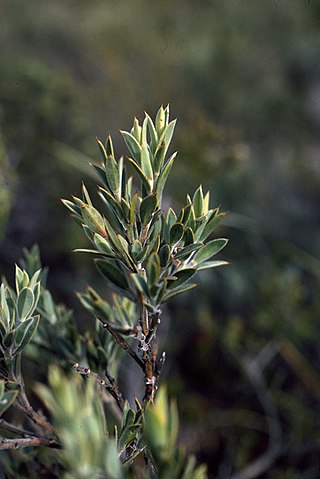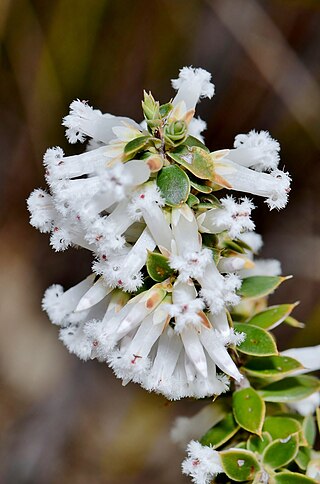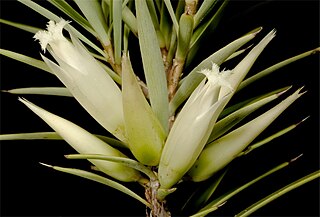
Grevillea treueriana, also known as Mount Finke grevillea or scarlet grevillea, is a species of flowering plant in the family Proteaceae and is endemic to Mount Finke in South Australia. It is a shrub with pinnatisect leaves with 3 to 7 lobes, the end lobes linear and sharply pointed, and bright scarlet flowers on one side of the floral rachis.
Persoonia brachystylis is a species of flowering plant in the family Proteaceae and is endemic to a restricted area on the west coast of Western Australia. It is an erect, spreading shrub with smooth bark, narrow spatula-shaped to lance-shaped leaves and yellow flowers in groups of ten to twenty.

Grevillea disjuncta is a species of flowering plant in the family Proteaceae and is endemic to the south-west of Western Australia. It is low, mounded or spreading shrub with linear to more or less needle-shaped leaves and small groups of pale orange to bright red and green or yellow flowers.

Grevillea oligantha is a species of flowering plant in the family Proteaceae and is endemic to southern Western Australia. It is dense shrub with many erect branches, egg-shaped, lance-shaped or linear leaves, and groups of up to six brownish-yellow, orange or reddish-brown flowers with a pale yellow to reddish style.

Grevillea paradoxa, commonly known as the bottlebrush grevillea, is a species of flowering plant in the family Proteaceae and is endemic to the south-west of Western Australia. It is an erect to spreading, prickly shrub with pinnatipartite leaves, the lobes linear, widely spreading and sharply pointed, and with cylindrical clusters of pale to dark pink or cream-coloured flowers with a pinkish-red style.

Grevillea patentiloba is a species of flowering plant in the family Proteaceae and is endemic to the south-west of Western Australia. It is a prostrate to erect, spreading to straggling shrub with divided leaves, and down-turned clusters of red to deep pink and cream-coloured to bright yellow flowers with a red to deep pink style.

Grevillea pityophylla is a species of flowering plant in the family Proteaceae and is endemic to inland areas of Western Australia. It is a dense shrub with linear to more or less cylindrical leaves and hairy, pinkish-red to bright red flowers.

Grevillea sparsiflora, commonly known as sparse flowered grevillea, is a species of flowering plant in the family Proteaceae and is endemic to the south of Western Australia. It is a low, spreading shrub with crowded, linear leaves and pinkish-red flowers arranged singly or in groups of up to five.

Grevillea trachytheca, commonly known as rough-fruit grevillea, is a species of flowering plant in the family Proteaceae and is endemic to the south-west of Western Australia. It is an erect to spreading shrub with hairy branchlets, mostly broadly linear leaves, and white to cream-coloured and yellow flowers with a white style.

Petrophile megalostegia is a species of flowering plant in the family Proteaceae and is endemic to southwestern Western Australia. It is a shrub with needle-shaped or flattened, sometimes S-shaped leaves with a sharply-pointed tip, and more or less cylindrical heads of silky-hairy, yellow to cream-coloured flowers.

Isopogon tridens, commonly known as the three-toothed coneflower, is a species of flowering plant in the family Proteaceae and is endemic to the southwest of Western Australia. It is a shrub with wedge-shaped leaves with two or three sharply-pointed teeth, and flattened-spherical heads of glabrous creamy white, sometimes purple flowers.

Daviesia abnormis is a species of flowering plant in the family Fabaceae and is endemic to the south-west of Western Australia. It is an erect, hairy shrub with sharply-pointed, narrow elliptic to narrow egg-shaped phyllodes with the narrower end towards the base, and yellow flowers with faint red markings.

Daviesia cardiophylla is a species of flowering plant in the family Fabaceae and is endemic to the southwest of Western Australia. It is an erect, spreading shrub with heart-shaped, sharply pointed phyllodes and yellow and red flowers.

Hemigenia teretiuscula is a species of flowering plant in the family Lamiaceae and is endemic to the southwest of Western Australia. It is an upright, glabrous shrub that typically grows to a height of 10–80 cm (3.9–31.5 in), the leaves about 1 mm (0.039 in) in diameter, more or less tapering cylindrical and somewhat sharply pointed. Flowering usually occurs from August to December and the flowers are bluish-purple.

Styphelia erubescens is a species of flowering plant in the heath family Ericaceae and is endemic to the south-west of Western Australia. It is an erect shrub with variably-shaped leaves with a small, sharp point on the tip, and white, pink or red, tube-shaped flowers.

Styphelia hainesii is a species of flowering plant in the heath family Ericaceae and is endemic to the south coast of Western Australia. It is a bushy shrub with egg-shaped leaves, the narrower end towards the base, and red, tube-shaped flowers arranged singly in leaf axils.

Styphelia macrocalyx, commonly known as Swan berry, is a species of flowering plant in the heath family Ericaceae and is endemic to the south west of Western Australia. It is a shrub with sharply pointed, narrowly lance-shaped leaves and white, tube-shaped flowers with tufts of hairs on the inside.

Lissanthe pluriloculata is a species of flowering plant in the family Ericaceae and is endemic to Queensland. It is a small, bushy shrub with sharply-pointed linear leaves and spikes or racemes of tube-shaped, white flowers.

Lissanthe rubicunda is a species of flowering plant in the family Ericaceae and is endemic to the south of Western Australia. It is a slender, erect to spreading shrub with few branches and sharply-pointed linear leaves and short spikes or racemes of red, tube-shaped flowers.
Styphelia subulata is a species of flowering plant in the heath family Ericaceae and is endemic to the south-west of Western Australia. It is a rigid shrub with many branches, usually sharply-pointed, linear leaves and usually one or two white, tube-shaped flowers in leaf axils.



















